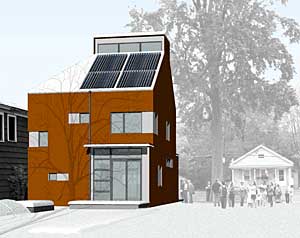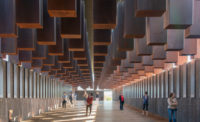Shortly after becoming chancellor of Syracuse University in 2005, Nancy Cantor introduced her Scholarship in Action initiative, which aims to meld academic study with community redevelopment efforts. As part of that wide-ranging effort, the Syracuse University School of Architecture, led by dean Mark Robbins, spawned a local design-build workshop, as well as a Gluckman Mayner–designed renovation of an old furniture warehouse in downtown Syracuse that now contains classrooms, a cafe, and an art gallery.



The most recent undertaking in this series of efforts is the competition "From the Ground Up: Innovative Green Homes," which will introduce three exemplary sustainable homes to a nearby neighborhood straitened by deindustrialization. The SU architecture school revealed the contest winners, selected by an 11-person jury, on January 22: Architecture Research Office (ARO) with Della Valle Bernheimer, both based in New York; Cook+Fox Architects, also of New York, with Terrapin Bright Green, a sustainability consultant; and the Philadelphia design-build firm Onion Flats.
The competition invited designers to conceive a single-family home embodying progressive sustainability tactics that could be built for $150,000. More than 50 designers responded to the open call for concepts announced last August. The winning plans, described below, offer different approaches to affordable, sustainable housing. Each will be constructed by the nonprofit group, Home HeadQuarters, in the Near Westside, one of the poorest neighborhoods in Syracuse.
Although the “From the Ground Up” building sites are yet to be determined, the organizers certainly have wider deployment in mind. “It seems to me that Syracuse is a great example of a postindustrial city, and there are many cities both in the Rust Belt and across the country that have near-in urban neighborhoods that have suffered the same disinvestment and shrinking population,” Robbins says. “My sense is that what we learn from working in this community is generalizable to many places in the country.”
THE WINNERS
R-House
ARO and Della Valle Bernheimer claim that their R-House can be heated with the amount of energy used to run a hair dryer. The flexible and otherwise modestly appointed building’s most salient green feature is its adherence to German Passivhaus criteria, which Jared Della Valle, AIA, says “utilizes a well-insulated envelope, airtight construction, an efficient small heating system, controlled ventilation, and windows that optimize solar gain.” ARO principal Adam Yarinsky, FAIA, notes, too, that the exterior, in which a traditional gable is reshaped into a folded facade, “connects to the diverse scale and character of the neighborhood. Our desire was to find something that would be familiar on the one hand and progressive on the other.”
The duo had collaborated before, most notably on an affordable multifamily project in New York’s East New York neighborhood. This previous project “mostly informed an attitude about diversity and how we would help people build a community and connect to pieces of architecture,” Della Valle says. “Also, I think we learned a fair amount about material qualities and how they relate to budget.”
Live Work Home
The Cook+Fox design refutes even the hint of domestic iconography. That competition submission envisions a one-story structure not unlike the light industrial buildings and corner groceries interspersed among the Near Westside’s Victorian piles and bungalows. Rick Cook, FAIA, notes that the composition nods to the urban fabric, but he adds, “Our thought was to project the almost universal quality of a converted loft space, and to send a message that that’s the kind of building it was.” Indeed, the flat-roofed building houses a prefabricated furniture system that can be reconfigured for live and work formats, as well as various occupancy scenarios ranging from a nuclear family to off-campus housing.
The so-called Live Work Home also opts for passive heating: It achieves a tight building envelope via structural insulated panels (SIPs) working in concert with a heat recovery ventilator. Skylights, as well as reflective coating inside an incised screen belting the house, coax daylight deep into the interior.
Ted
Onion Flats cofounder Timothy McDonald says that Ted—the housing concept is named for design team member Ted Singer—chooses traditional two-by-six stick construction over a method like SIPs. This concept devotes a portion of its budget to a Grade 1 insulation package and to a solar heating array mounted on the three-story house’s roof. An interior atrium stacks heat and amplifies natural ventilation in the warmer months.
McDonald, whose firm largely develops the buildings it designs and constructs, says this combination of passive and active techniques “is what we have found to work really well in this climate.” The building’s familiar fabrication technique may be grasped by any local builder, too. McDonald projects that this ease of comprehension, as well as “a plan that could work in many different orientations,” would allow Ted to be replicated on a larger scale.



Post a comment to this article
Report Abusive Comment